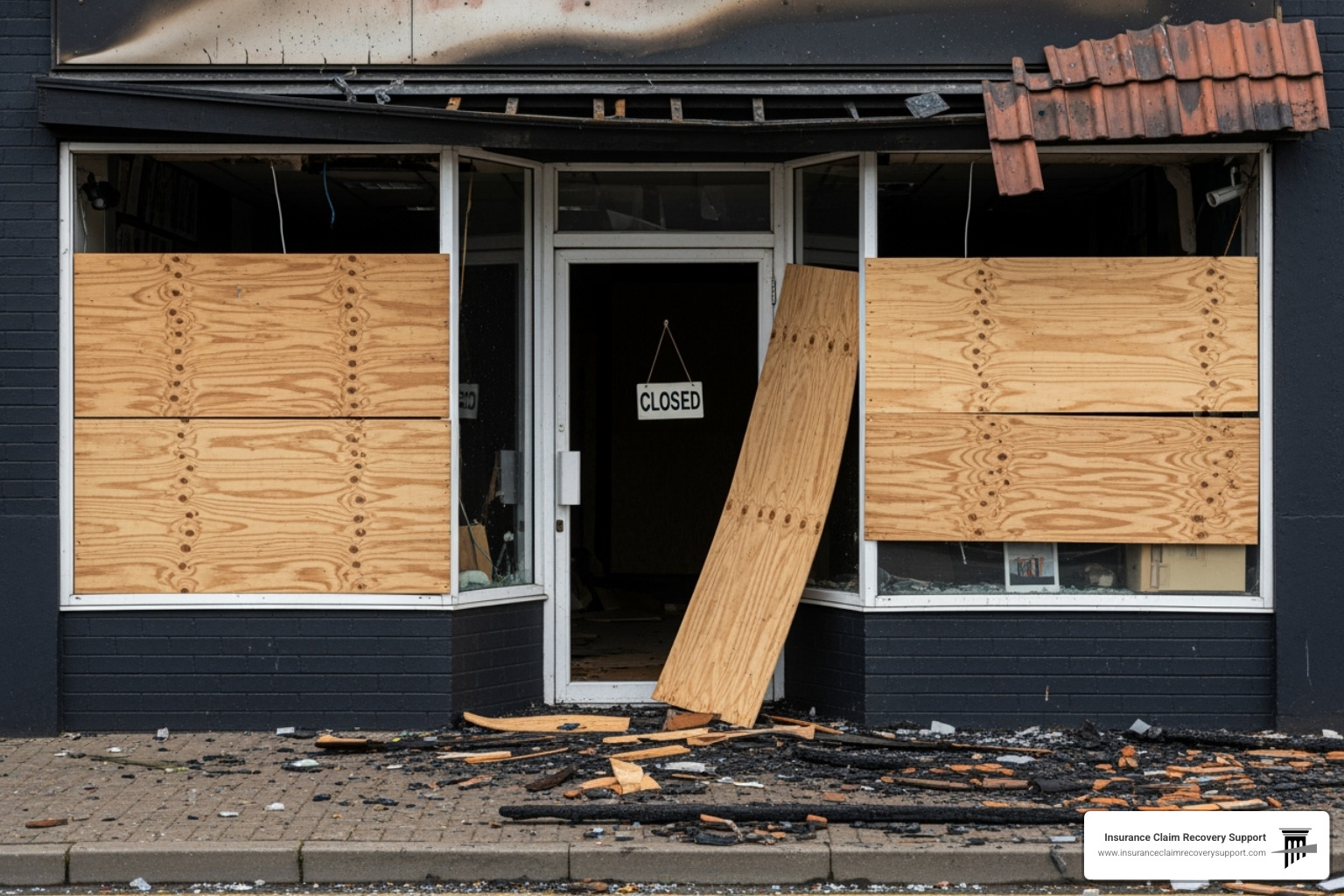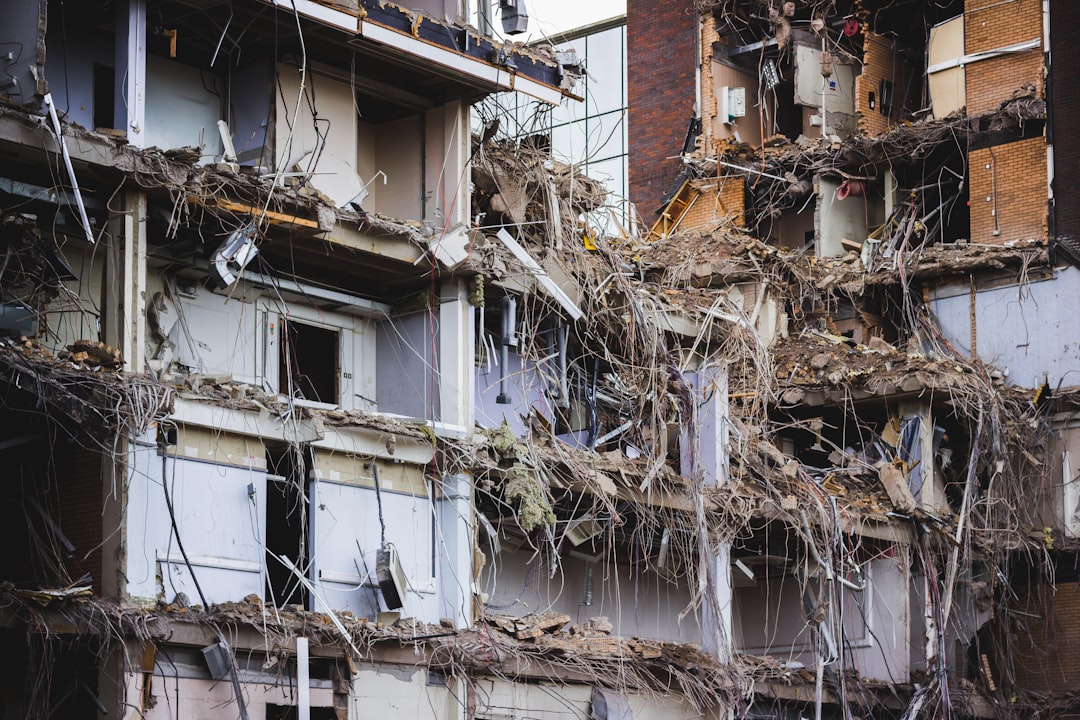Understanding Freeze Damage Claims in Texas
Freeze damage claims can be overwhelming, especially after experiencing harsh winter conditions in Texas. The main steps involved in handling these claims include:
- Inspect and Document: Identify and document all visible damage.
- Understand Your Policy: Check your insurance policy for coverage specifics.
- Submit Claims Promptly: File the claim within the policy’s deadlines.
- Seek Professional Help: Consider hiring a public adjuster for guidance.
In February 2021, Texas was hit by one of the most costly winter storms in U.S. history. Damages from burst pipes and ice dams caused significant headaches for property owners statewide, making it essential to understand the ins and outs of your insurance policy and the claims process.
As Scott Friedson, CEO of Insurance Claim Recovery Support, I’ve settled hundreds of large loss cases, including freeze damage claims. My experience equips me to help you steer this complex process and ensure your property is restored.
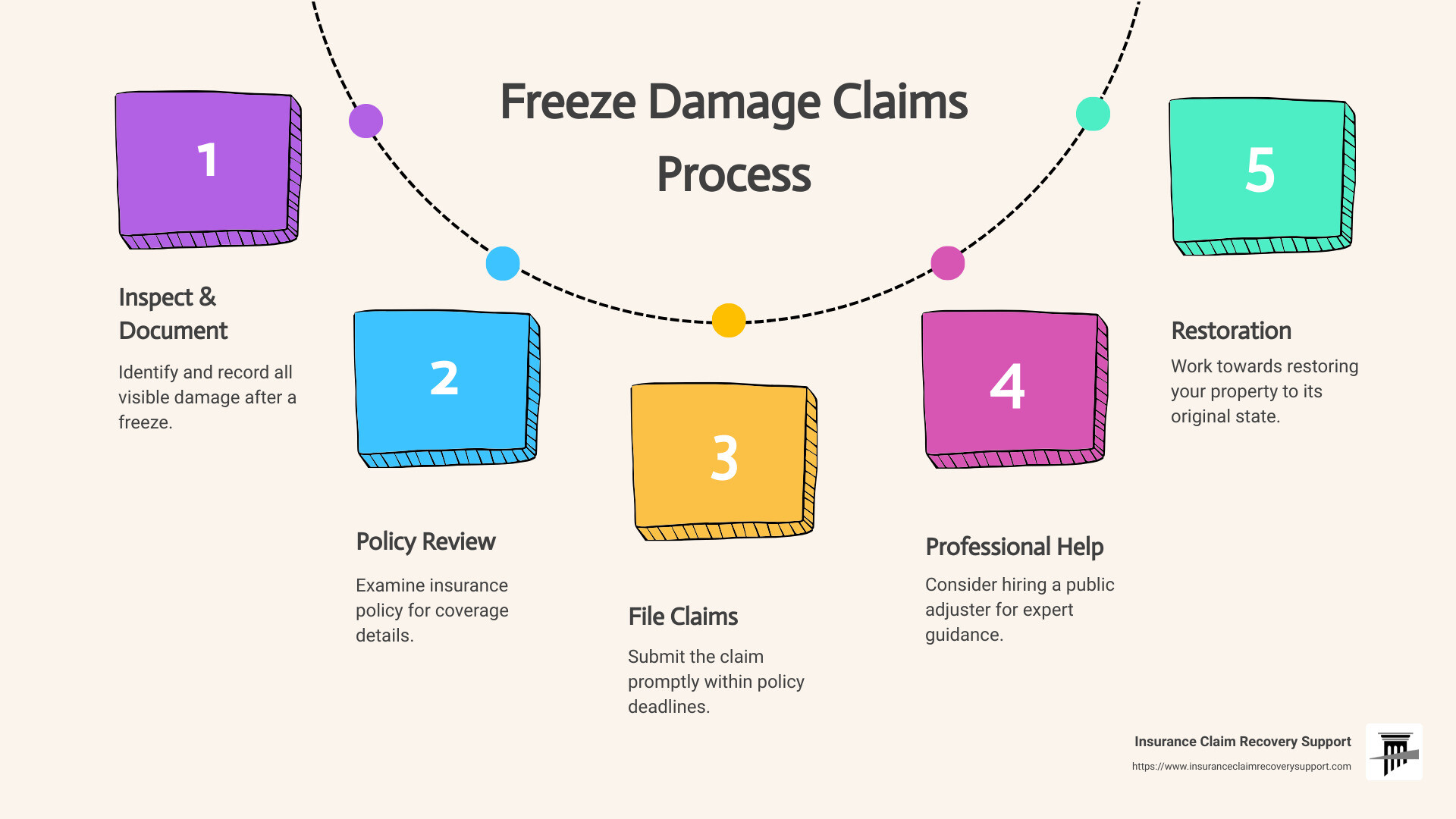
What is Freeze Damage?
Freeze damage occurs when water freezes inside structures, leading to serious issues like frozen pipes, ice dams, and structural damage. Let’s break down these common problems:
Frozen Pipes
Frozen pipes are a major concern in colder weather. When temperatures drop, water inside the pipes can freeze. This causes the water to expand, which may lead to the pipes bursting. Burst pipes can result in significant water damage to walls, floors, and personal belongings.
Quick Fact: During the 2021 Texas winter storm, thousands of homeowners experienced burst pipes, leading to billions in insurance claims.
Ice Dams
Ice dams form on roofs when snow melts, runs down to the edge, and refreezes. This creates a barrier that prevents melting snow from draining off the roof. The trapped water can seep into the home, damaging walls, ceilings, and insulation.
Prevention Tip: Ensure proper attic insulation and ventilation to minimize the risk of ice dams.
Structural Damage
When water freezes, it expands. This can cause structural damage to buildings. Cracks in walls and foundations may appear, leading to long-term stability issues. If left unchecked, the integrity of the building can be compromised, resulting in costly repairs.
Real-Life Example: In Texas, many buildings suffered structural damage due to the freeze, highlighting the importance of timely inspections and repairs.
Understanding these aspects of freeze damage is crucial for homeowners and property managers in Texas. Knowing the risks allows you to take preventive measures and prepare for potential insurance claims.
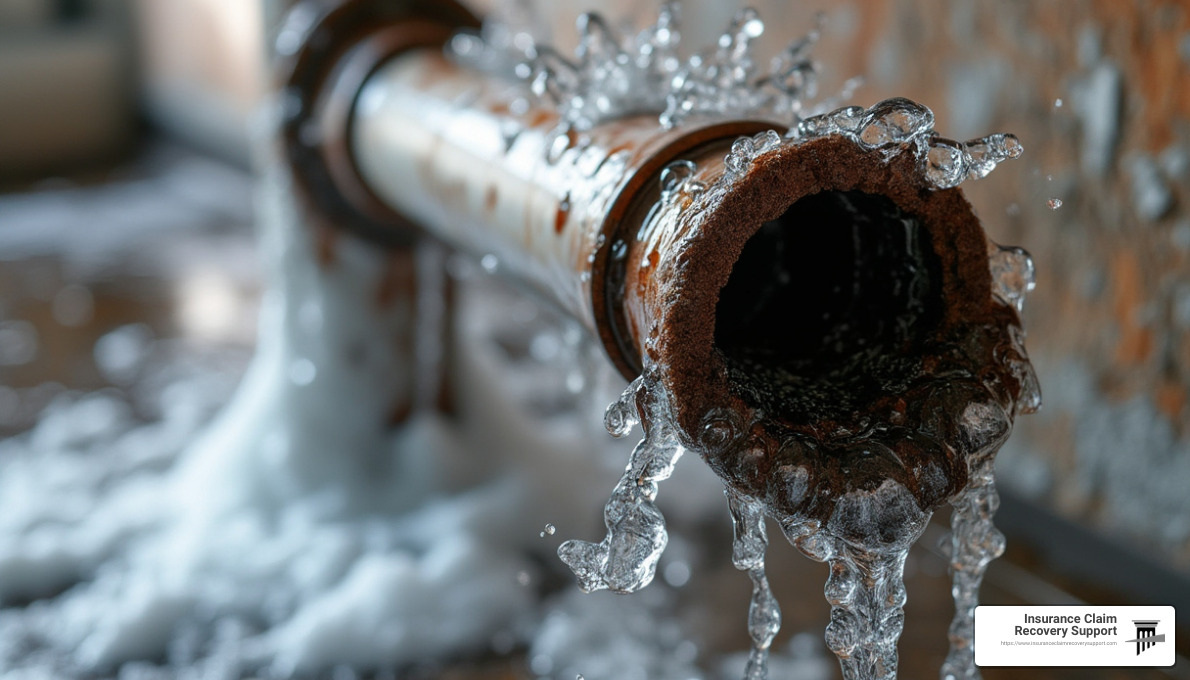
Next, we’ll discuss the Freeze Damage Claims Process, including insurance coverage, filing claims, and necessary documentation.
Freeze Damage Claims Process
Navigating the freeze damage claims process can feel overwhelming, especially in the aftermath of a severe weather event. However, understanding insurance coverage, claim filing, and proper documentation can make the process smoother.
Insurance Coverage
Insurance policies often cover freeze damage under water damage provisions. This typically includes sudden and accidental incidents like burst pipes or ice dams. However, coverage can vary. It’s essential to review your policy to understand the specific terms and conditions.
Important Note: Standard policies may not cover damage due to negligence, such as failing to maintain a warm enough environment to prevent freezing. Always ensure your home is adequately prepared for cold weather to avoid such issues.
Claim Filing
Once you’ve assessed the damage, it’s crucial to file your claim promptly. Contact your insurance provider to initiate the process. They will guide you on the specific requirements and timelines.
Steps to File a Claim:
- Contact your insurer immediately after finding the damage.
- Provide a detailed account of the damage, including when and how it occurred.
- Submit all required forms and follow your insurer’s instructions closely.
Filing quickly helps prevent delays in processing and ensures that repairs can begin as soon as possible.
Documentation
Thorough documentation is key to a successful claim. This involves collecting clear evidence of all damage and maintaining records of all interactions with your insurance company.
Essential Documentation Tips:
- Take photos and videos of all affected areas, capturing the extent of the damage.
- Keep a detailed list of damaged items and any expenses incurred, such as temporary repairs or accommodations.
- Record all communications with your insurer, including phone calls and emails, to have a comprehensive log of the claim process.
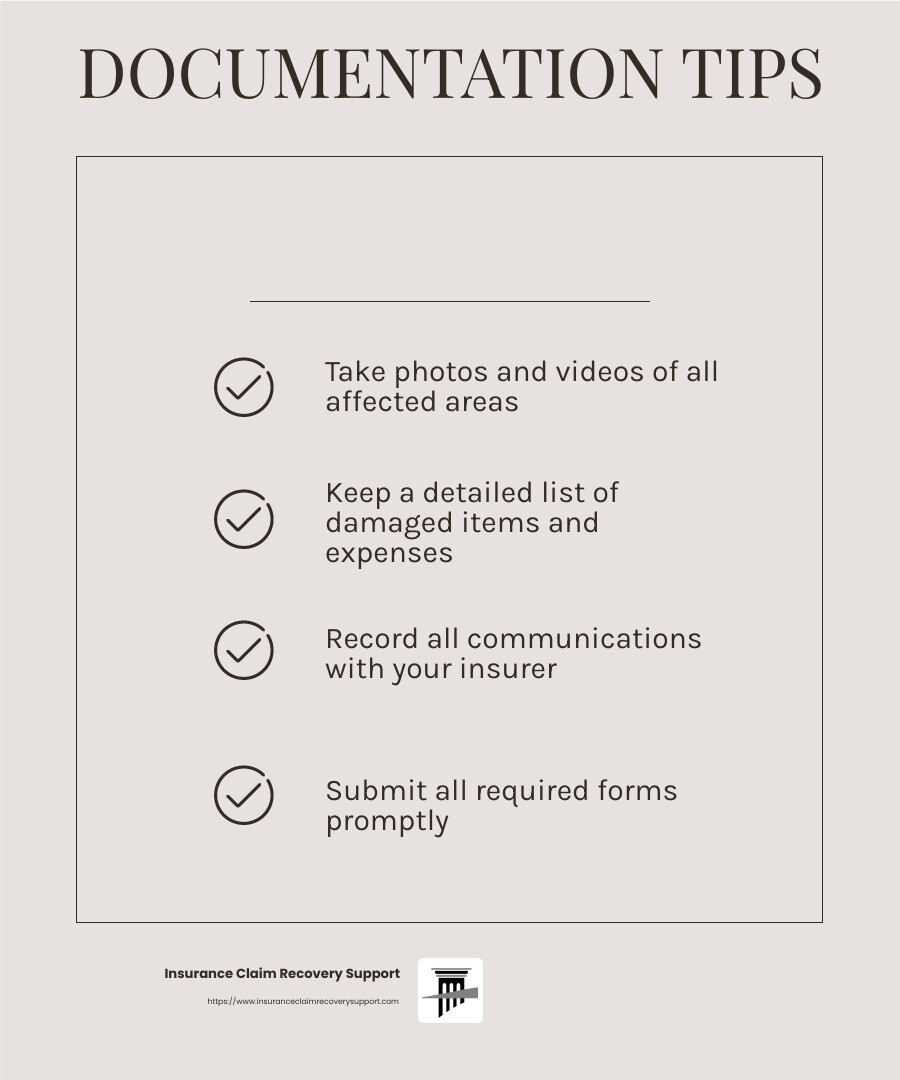
By understanding your insurance coverage, filing your claim promptly, and maintaining meticulous documentation, you can steer the freeze damage claims process more effectively. This preparation not only aids in securing fair compensation but also speeds up the recovery process for your property.
Next, we’ll explore the Common Areas Affected by Freeze Damage, focusing on vulnerable parts of the home like pipes, roofs, and foundations.
Common Areas Affected by Freeze Damage
When winter strikes, certain parts of your home are more vulnerable to freeze damage. Understanding these areas can help you take preventive measures and know where to look first if damage occurs.
Pipes
Location: Pipes in unheated spaces, such as basements, crawl spaces, and exterior walls, are particularly at risk.
Impact: When temperatures drop, water inside the pipes can freeze, expand, and cause the pipes to burst. This can lead to significant water damage, disrupting your home’s water supply and potentially damaging walls, floors, and belongings.
Prevention: Insulate your pipes, especially those in unheated areas. During extreme cold, keep a trickle of water flowing through faucets to prevent freezing.
Roofs
Location: Roofs, especially those with poor insulation or ventilation, can develop problems during a freeze.
Impact: Ice dams form when heat from the house melts snow on the roof, which then refreezes at the eaves. This ice barrier prevents proper drainage, causing water to back up under shingles and leak into the home, damaging ceilings and walls.
Prevention: Ensure your attic is well-insulated and ventilated to maintain a consistent roof temperature. Regularly clear gutters and downspouts to facilitate drainage.
Foundations
Location: The foundation of your home is another area susceptible to freeze damage, particularly when water accumulates around it.
Impact: Water in the soil surrounding the foundation can freeze and expand, putting pressure on the foundation walls. This can lead to cracks and structural damage, compromising the stability of your home.
Prevention: Ensure proper drainage away from the foundation by sloping the ground and maintaining gutters and downspouts. Insulating your foundation walls can also help mitigate this risk.
Understanding these common areas affected by freeze damage allows you to take proactive steps to protect your home. In the next section, we’ll discuss strategies for preventing freeze damage, including insulation tips and maintaining your pipes and attic.
Preventing Freeze Damage
Taking steps to prevent freeze damage can save you a lot of trouble and money. Let’s look at some simple ways to protect your home from freezing temperatures.
Insulation
Why Insulate? Insulation is your home’s first line of defense against the cold. Proper insulation keeps warm air in and cold air out, reducing the risk of freezing.
Where to Insulate? Focus on areas like attics, walls, and basements. Also, insulate pipes in unheated spaces. This helps maintain a stable temperature and prevents water in pipes from freezing.
How to Insulate? Use materials like fiberglass or foam board. For pipes, consider using pipe sleeves or heat tape. These are affordable and easy to install.
Pipe Maintenance
Check Regularly: Inspect your pipes for cracks or leaks before winter hits. Even small issues can lead to big problems when temperatures drop.
Keep Them Warm: Besides insulating, keep cabinet doors open to allow warm air to circulate around pipes under sinks. Letting faucets drip during extreme cold can also prevent freezing.
Know Your System: Familiarize yourself with the location of the main water shut-off valve. In case of a pipe burst, shutting off the water quickly can minimize damage.
Attic Ventilation
Why Ventilate? Proper ventilation in your attic helps prevent ice dams, which can cause water damage to your home.
How to Ventilate? Ensure your attic has enough vents to allow air to flow freely. This helps keep the roof at a consistent temperature, reducing the risk of snow melting and refreezing at the eaves.
Additional Tips: Check your attic insulation. It should be thick enough to keep heat from escaping into the attic but not so thick that it blocks ventilation.
By focusing on insulation, pipe maintenance, and attic ventilation, you can effectively prevent freeze damage in your home. These proactive steps not only protect your property but also provide peace of mind during the winter months.
Next, we’ll tackle some frequently asked questions about freeze damage claims, including what insurance covers and steps to take after damage occurs.
Frequently Asked Questions about Freeze Damage Claims
Does insurance cover freeze damage?
Yes, but… Homeowners insurance usually covers sudden and accidental water damage, like burst pipes. However, it won’t cover damage if you didn’t take steps to prevent freezing. For example, if you didn’t maintain heat in your home or failed to shut off the water supply during your absence, your claim might be denied.
It’s crucial to check your policy for specific requirements. Some policies require that you maintain a certain temperature or shut off the water supply when you’re not home.
What steps should I take after freeze damage occurs?
-
Shut off the water: Locate your main water shut-off valve and turn it off immediately to prevent further damage.
-
Document everything: Take plenty of photos and videos of the affected areas. This includes visible damage to walls, floors, and belongings. The more evidence you have, the stronger your claim will be.
-
Contact your insurance company: Notify them about the damage and start the claim process as soon as possible. Keep records of all communications.
-
Start cleanup and repairs: Once you’ve documented the damage, begin drying out affected areas to prevent mold growth. You may need to hire a professional water mitigation company to assist with this.
How can I prevent my pipes from freezing?
-
Insulation: Use pipe sleeves or heat tape to insulate pipes in unheated areas like basements or crawl spaces. This helps keep the pipes warm even when temperatures drop.
-
Heat maintenance: Keep your home heated, even if you’re away. Set your thermostat to at least 55°F to ensure pipes don’t freeze.
-
Allow faucets to drip: During extreme cold, let faucets drip slightly. This keeps water moving and reduces the chance of freezing.
-
Open cabinet doors: Allow warm air to circulate around pipes under sinks by keeping cabinet doors open.
By taking these steps, you can reduce the risk of freeze damage and ensure you’re prepared if a claim becomes necessary. Stay vigilant, and remember that proactive measures can save you from costly repairs and claim denials.
Conclusion
At Insurance Claim Recovery Support, we stand by you through every step of your freeze damage claim. Our mission is simple: to advocate for you, the policyholder, and ensure you receive the maximum settlement you deserve.
Why Choose Us?
We are proud to serve policyholders across Texas, including Austin, Dallas, Fort Worth, San Antonio, Houston, and beyond. Our Texas roots mean we understand the challenges you face, from unexpected ice storms to fluctuating winter temperatures. We know how to steer the complexities of insurance claims in these situations.
Our Commitment to Policyholder Advocacy
Navigating the claims process can be daunting. But you don’t have to do it alone. We specialize in settling property damage claims, and our team of experts is dedicated to leveling the playing field between you and your insurance company. We work on a contingency basis, so we only get paid when you do. This means our success is directly tied to yours.
Texas Locations We Serve
Whether you’re in Lubbock, San Angelo, Waco, Round Rock, Georgetown, or Lakeway, we’re here to help. We provide comprehensive support and guidance custom to your specific needs and location. Our extensive experience with Texas’s unique weather patterns allows us to offer insights and strategies that other firms simply can’t match.
In conclusion, freeze damage claims can be complex, but with the right support, you can steer them successfully. At Insurance Claim Recovery Support, we’re committed to standing by your side, advocating for your rights, and helping you recover swiftly and fully. Reach out to us today and let us help you turn frost into funds.


